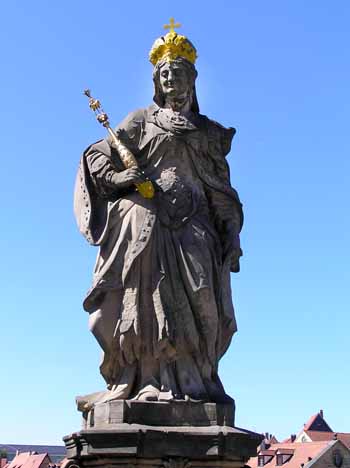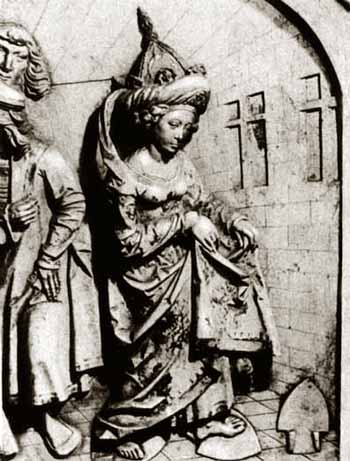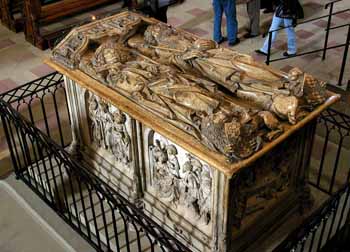Saints of the Day
 |
 |
 |
 |
 |
 |
 |
St. Cunegundes, Empress - II - March 3
Comments of Dr. Plinio:
Cunegundes, Countess of Luxembourg, was born by the end of the 10th century. Her father Count Sigfried and her mother Countess Hedwig, Sovereigns of Luxembourg, favored by fortune, gave an exquisite formation to the Princess, whose beauty and intelligence grew with age.
 Since childhood, she showed a constant inclination toward holy things. The desire to serve God and the Most Holy Virgin in perfect chastity rose spontaneously in her heart. God miraculously helped her to fulfill that holy longing.
Since childhood, she showed a constant inclination toward holy things. The desire to serve God and the Most Holy Virgin in perfect chastity rose spontaneously in her heart. God miraculously helped her to fulfill that holy longing.
Unable to avoid the duties of her birth, she accepted Henry, then Duke of Bavaria, as her husband. With her husband she received the Imperial Crown from the hands of Pope Benedict VIII in Rome in the year 1014.
Pious and with great virtue, Henry esteemed chastity as highly as did his wife. On the day of their wedding they made, by common accord, the vow of chastity, thus allaying the probable disastrous consequences of that political marriage.
They lived in joy, energetically working for the greater glory of God and the happiness of their subjects.
Such great virtue in such a high place was a natural of concern for the Enemy of all good. Suddenly everywhere in the Imperial Court the rumor began to spread that the Empress was unfaithful to her husband. At first Cunegundes suffered the calumny raised against her honor with patience although her whole being was revolted against such a great evil.
 But when the rumors grew and did not subside, Cunegundes realized that she could no longer ignore them because of the dire consequences they could cause. When she saw that even her husband was manifesting doubts, the Empress made a public declaration refuting the calumnies of her detractors. To confirm her words she walked barefooted on red-hot irons asking that God be the witness of her virtue. She emerged unharmed from the ordeal.
But when the rumors grew and did not subside, Cunegundes realized that she could no longer ignore them because of the dire consequences they could cause. When she saw that even her husband was manifesting doubts, the Empress made a public declaration refuting the calumnies of her detractors. To confirm her words she walked barefooted on red-hot irons asking that God be the witness of her virtue. She emerged unharmed from the ordeal.
Seeing that great miracle, no one dared again to challenge her sanctity and the Emperor himself knelt at her feet to asked forgiveness for his temerarious judgment.
In 1025, one year after the death of the Emperor, Cunegundes presented herself dressed in her full Imperial Regalia at the church of Kaufungen Abbey in Hesse, Germany, a convent she had founded. There she made her solemn vows and entered the religious life. Present at the ceremony were many of the Clergy and the Court.
After the ceremony, Cunegundes offered the Abbey a small piece of the Holy Cross that she, as Empress, had the privilege to possess. At the end of the Gospel of the Mass celebrated on that occasion, she removed the Imperial Regalia to replace it with the simple habit of the Benedictine Order, a habit she had sewn with her own hands. Then, after her hair was cut and her head covered with a veil, a Prelate walked her to the door of the cloistered convent, which she entered.
 Thenceforth she lived subject to the Rule and holy obedience, giving to her sisters the example of the practice of great virtue.
Thenceforth she lived subject to the Rule and holy obedience, giving to her sisters the example of the practice of great virtue.
As her death approached in 1040, she realized that the nuns had brought precious garments to bury the body of the one who had been the Empress of Germany. Then she asked – she could no longer command – that they allow her to be buried in the simple habit of the Order alongside her virtuous spouse and lord.
Tradition says that when the tomb was opened, a voice was heard saying: "O virgo virgini, locum tribue!" (O virgin husband, give a place to your virgin wife). And Henry's coffin spontaneously moved to give a place for Cunegundes' to be placed next to it.
The double tomb of these Monarchs was glorified by countless miracles. In 1200 Cunegundes was canonized by Pope Innocent III.

O Legionario, February 26, 1939, n. 337, p. 5


More on St. Cunegundes

The Saint of the Day features highlights from the lives of saints based on comments made by the late Prof. Plinio Corrêa de Oliveira. Following the example of St. John Bosco who used to make similar talks for the boys of his College, each evening it was Prof. Plinio’s custom to make a short commentary on the lives of the next day’s saint in a meeting for youth in order to encourage them in the practice of virtue and love for the Catholic Church. TIA thought that its readers could profit from these valuable commentaries.
The texts of both the biographical data and the comments come from personal notes taken by Atila S. Guimarães from 1964 to 1995. Given the fact that the source is a personal notebook, it is possible that at times the biographic notes transcribed here will not rigorously follow the original text read by Prof. Plinio. The commentaries have also been adapted and translated for TIA’s site.
Cunegundes, Countess of Luxembourg, was born by the end of the 10th century. Her father Count Sigfried and her mother Countess Hedwig, Sovereigns of Luxembourg, favored by fortune, gave an exquisite formation to the Princess, whose beauty and intelligence grew with age.

The Empress St. Cunegundes, honored in a plaza in Bamberg, Germany
Unable to avoid the duties of her birth, she accepted Henry, then Duke of Bavaria, as her husband. With her husband she received the Imperial Crown from the hands of Pope Benedict VIII in Rome in the year 1014.
Pious and with great virtue, Henry esteemed chastity as highly as did his wife. On the day of their wedding they made, by common accord, the vow of chastity, thus allaying the probable disastrous consequences of that political marriage.
They lived in joy, energetically working for the greater glory of God and the happiness of their subjects.
Such great virtue in such a high place was a natural of concern for the Enemy of all good. Suddenly everywhere in the Imperial Court the rumor began to spread that the Empress was unfaithful to her husband. At first Cunegundes suffered the calumny raised against her honor with patience although her whole being was revolted against such a great evil.

To prove her innocence, Cunegundes walked over red-hot ploughshares unharmed
Seeing that great miracle, no one dared again to challenge her sanctity and the Emperor himself knelt at her feet to asked forgiveness for his temerarious judgment.
In 1025, one year after the death of the Emperor, Cunegundes presented herself dressed in her full Imperial Regalia at the church of Kaufungen Abbey in Hesse, Germany, a convent she had founded. There she made her solemn vows and entered the religious life. Present at the ceremony were many of the Clergy and the Court.
After the ceremony, Cunegundes offered the Abbey a small piece of the Holy Cross that she, as Empress, had the privilege to possess. At the end of the Gospel of the Mass celebrated on that occasion, she removed the Imperial Regalia to replace it with the simple habit of the Benedictine Order, a habit she had sewn with her own hands. Then, after her hair was cut and her head covered with a veil, a Prelate walked her to the door of the cloistered convent, which she entered.

The double tomb of the imperial couple in Bamberg Cathedral
As her death approached in 1040, she realized that the nuns had brought precious garments to bury the body of the one who had been the Empress of Germany. Then she asked – she could no longer command – that they allow her to be buried in the simple habit of the Order alongside her virtuous spouse and lord.
Tradition says that when the tomb was opened, a voice was heard saying: "O virgo virgini, locum tribue!" (O virgin husband, give a place to your virgin wife). And Henry's coffin spontaneously moved to give a place for Cunegundes' to be placed next to it.
The double tomb of these Monarchs was glorified by countless miracles. In 1200 Cunegundes was canonized by Pope Innocent III.

The crown of Empress Cunegundes
O Legionario, February 26, 1939, n. 337, p. 5

 | |
|
|
The texts of both the biographical data and the comments come from personal notes taken by Atila S. Guimarães from 1964 to 1995. Given the fact that the source is a personal notebook, it is possible that at times the biographic notes transcribed here will not rigorously follow the original text read by Prof. Plinio. The commentaries have also been adapted and translated for TIA’s site.


